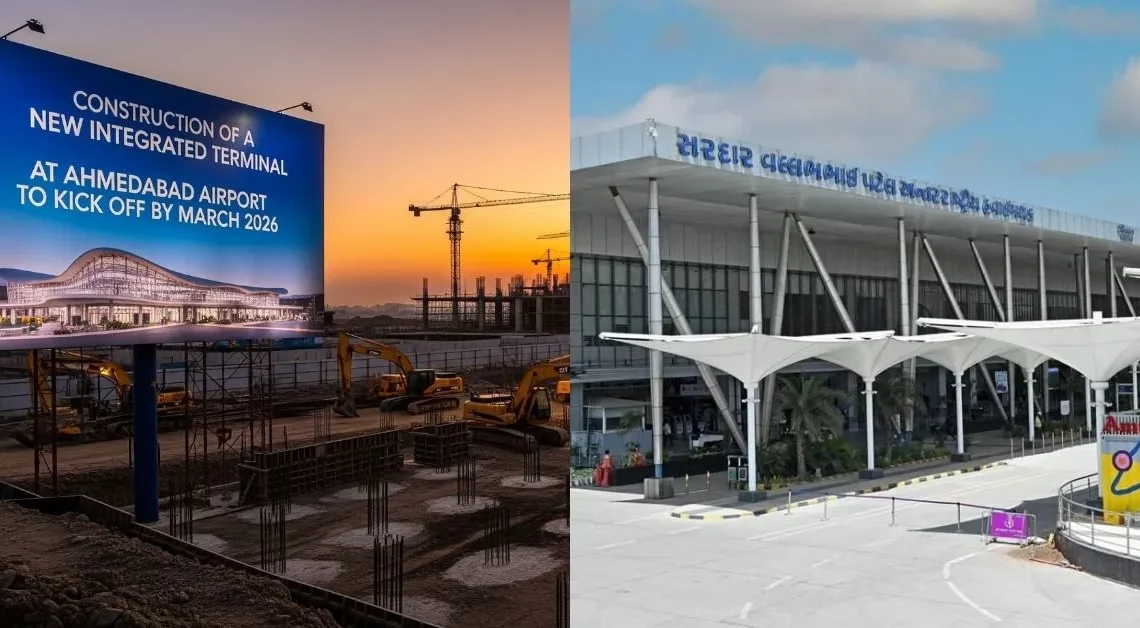
India’s aviation sector is rapidly evolving, and Ahmedabad is poised to witness a major transformation. The Sardar Vallabhbhai Patel International Airport (SVPIA) is all set for a major upgrade, with a new integrated terminal expected to break ground by March 2026. This move not only promises to enhance passenger experience but also signifies Ahmedabad’s growing importance on both national and international aviation maps.
Why Ahmedabad Airport Needs an Upgrade
Over the past decade, Ahmedabad has seen a consistent rise in passenger traffic. The city is a vital hub for business, education, and tourism, with increasing connectivity demands. The current domestic and international terminals at SVPIA are struggling to keep up with this growth.
The new integrated terminal will consolidate both domestic and international operations under one roof, aiming to streamline services and eliminate the inconvenience of transferring between terminals. As India continues to see exponential growth in air travel, modern and expanded airport infrastructure has become a necessity, not a luxury.
Scope of the New Terminal
The Airports Authority of India (AAI), along with private stakeholders, is leading the charge to deliver this much-needed infrastructure. The terminal will reportedly cover over 1,20,000 square meters and will be capable of handling nearly 40 million passengers per year.
Key features will include:
- Modern check-in counters and baggage handling systems
- High-speed security and immigration processes
- Spacious waiting lounges and food courts
- Dedicated retail zones and duty-free outlets
- Better accessibility features for senior citizens and differently-abled passengers
This large-scale development will align Ahmedabad with other major Indian cities like Delhi, Mumbai, and Bengaluru in terms of aviation standards and capacity.
Sustainability and Design Goals
Today, no large infrastructure project can ignore its environmental impact. Ahmedabad’s new terminal is expected to follow green building standards and incorporate sustainable technologies. Natural lighting, rainwater harvesting, energy-efficient HVAC systems, and solar power generation will be core components of the terminal’s design.
In addition to functionality, aesthetics will also take center stage. The terminal design is expected to reflect a blend of modern engineering with local Gujarati architectural elements. This would not only offer comfort and efficiency to passengers but also give a unique cultural identity to the airport.
Timeline and Execution
Construction is expected to begin by March 2026, with a completion timeline of approximately 2–3 years. Given the scale of the project, it will be executed in phases to avoid disruption to current airport operations.
While the terminal will be constructed on a new site within the airport premises, integration with existing infrastructure is crucial. Authorities plan to ensure smooth transitions between the old and new systems during the switchover.
Economic and Regional Impact
The economic benefits of this project extend far beyond just airport operations. Construction alone is expected to generate thousands of jobs, while the completed terminal will support employment in retail, logistics, hospitality, and transport sectors.
Ahmedabad, already home to industries, startups, and GIFT City, will become more attractive to international investors and travelers with improved airport facilities. The terminal will support tourism, medical travel, and business activities, giving a boost to the region’s overall economy.
Improved airport connectivity can also reduce the pressure on nearby airports like Mumbai and Delhi, offering airlines more options for routing and hub operations.
Passenger Experience Upgrade
Travelers today expect airports to be efficient, clean, and technologically advanced. With this project, Ahmedabad aims to meet those expectations head-on.
Some of the major improvements that passengers can expect include:
- Faster check-in and baggage drop with self-service kiosks
- Biometric-based boarding systems
- Smart baggage tracking through mobile apps
- Expanded immigration and security areas for quicker clearance
- Comfortable seating, children’s play zones, and relaxation areas
Enhanced public transport integration and parking facilities are also part of the plan, making the journey smoother from the city to the terminal.
Strategic Vision for the Future
India is projected to become the third-largest aviation market in the world by 2030. With passenger numbers expected to double over the next decade, Indian airports must evolve now to avoid major infrastructure bottlenecks later.
Ahmedabad’s airport upgrade is a proactive step in that direction. It ensures the city is future-ready and aligned with the national strategy to build world-class aviation infrastructure under initiatives like UDAN and the National Civil Aviation Policy.
This terminal isn’t just about handling more passengers it’s about building smarter, more resilient airports that can adapt to future challenges, whether it’s increased passenger loads, health crises, or changing airline business models.
Challenges to Watch
Despite the enthusiasm, the road to completing this terminal isn’t entirely smooth. Key challenges include:
- Land acquisition and clearance delays
- Coordination between multiple agencies
- Funding and cost escalations
- Ensuring minimum disruption to current airport services
- Maintaining transparency and accountability in execution
Public-private partnership (PPP) models, as seen in airports like Delhi and Hyderabad, are likely to play a significant role in managing these risks and ensuring timely delivery.
Public Expectations and Reception
News of the upcoming terminal has been met with optimism among travelers, airport staff, airlines, and business communities. While construction might bring temporary inconveniences, the long-term benefits are clear.
Frequent flyers from Ahmedabad have long demanded better facilities, especially for international travel. With more airlines launching direct flights from the city, this terminal will address those needs while also supporting future routes.
Final Thoughts
The upcoming integrated terminal at Ahmedabad Airport represents a major step toward the city’s evolution as a global gateway. It reflects not only a need for better infrastructure but also a broader vision for growth, sustainability, and improved quality of life for citizens.
Once completed, this terminal will stand as a symbol of modern India efficient, inclusive, and future-ready. As construction gears up to begin by March 2026, Ahmedabad is firmly placing itself on the map as a major aviation and commercial hub.
